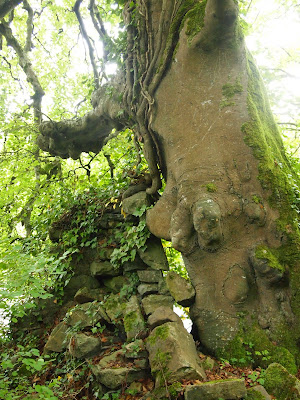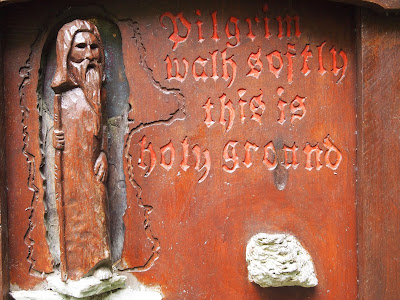It's been too many days to cover all in one post. Yesterday I can skip- it was an excellent kid's day at the Dublin Zoo, Pheonix Park, and a playground. Good times, but no need to elaborate. The day before, though, we went to County Wicklow, in particular to Powerscourt and Glendalough, both of which deserve some time (and photos). But I can't write it up today, because I'm so anxious to write about County Sligo- beautiful, magical, myth-filled, Yeats beloved Sligo. We've only been here half a day and I am already completely and utterly bewitched by this place. Not a surprise, I suppose, since we're just on the other side of Donegal Bay, and I fell in love with Donegal, too.

County Sligo is the northwestern-most part of Ireland, barring Donegal itself. It's wilder and more open than a lot of Ireland, and so far north there are few tourists here. We are, we think, leaning toward making the difficult decision to avoid most of the more southern places for which Ireland is most famous. We just don't have the time or money to visit every place. And even though we'd always planned on it, it now seems hard to justify going to Dingle, for example, for the "real Ireland" experience, when there will be thousands of tourists for the few hundred Irish who live there. Meanwhile, it is glorious up here, it wasn't too far to drive, and we're not swamped with anyone other than other Irish folks getting away.

We arrived at our B&B around 3pm (having passed a random stone circle in someone's field along the way) and immediately set out for a snack and someplace interesting to visit. We ended up right up the street at Drumcliffe Church. Most immediately pressing, it had a tea shop. After we ate something, we became significantly more interested in the fact that it was also the burial place of poet WB Yeats, the location of a medieval circular tower (left from an ancient monastery) and home to one of the best High Crosses in the country, erected in the 9th century.
Yeats is, I am discovering, a beautiful poet. I am shamefully ignorant of his work, despite his being well known. But we are in Yeats country now...as numerous signs reminds us. Yeats called Sligo "The Land of Heart's Desire." His poetry is full of references to natural landmarks in our immediate surrounding area, some of which we'll probably visit tomorrow. Yeats fell in love with Sligo during his numerous visits to his grandparents here. He moved to France for his health in the years before he died and was buried there. But he had made it clear, in the 6th stanza of his poem Under Benbulben, that he wanted to be buried at Drumcliffe Church, where his grandfather had served.
Under bare Ben Bulben's head
In Drumcliff churchyard Yeats is laid.
An ancestor was rector there
Long years ago, a church stands near,
By the road an ancient cross.
No marble, no conventional phrase;
On limestone quarried near the spot
By his command these words are cut:
Cast a cold eye
On life, on death.
Horseman, pass by!
And he was finally re-interred here, at the foot of Benbulben Mountain.
I almost got a book of Yeats poetry to read tonight, but opted instead to get a book of watercolors and descriptions of places around Sligo. I was hoping it would offer insight beyond what we were able to find in the books and online about what we might see in our far too short time here. And boy did it come through! I skimmed it in the car as we were trying to decide where to go next, and came across a very brief entry in the back, mentioning a place called Creevykeel Court Tomb, another neolithic passage tomb. I checked all three of the books we had brought- Frommers, Lonely Planet, and Hidden Places in Ireland (our host family's book). Nothing. I checked the map and couldn't find it anywhere. Finally, I spotted it, not too far up the coast from us. We drove up and almost past it- nothing but a small, empty parking lot and a tiny sign. We backed up, parked, and walked up the very short path that led behind a huge hedge.
At the first glimpse of stones, we noticed dozens of prayer flags had been tied twigs and branches.
We stepped into the clearing, and beheld Creevykeel.
And it was amazing.
Built the same time as Newgrange, Creevykeel has been left as it fell. There are standing stone circles and clear passages surrounded by masses of smaller stones.
With the exception of about 10 minutes when another couple blew in, snapped some photos and blew out again, we were completely alone the whole time we were there.
We were able to walk around quietly, pay attention to details (like this spiral of moss growing on one of the rocks)...it was another place where it was easy to fall into reverence.
Kaia and Tessa sensed it as well. Tess, after I told them we would tie prayer flags before we left, went over of her own accord, put her hands on one of the flags, took a deep breathe, and started to pray. I would have given just about anything to know what was in her little heart right then.
And both Kaia and Tessa wanted "alone time" in one of the open circles, so we all sat in our own sections, out of sight from one another.
And it wasn't in the books at all. It just sits there, in the sun and rain, holding 5000 years of sacred history within its circles, waiting for whoever is lucky enough to happen upon it.
After Creevykeel, we needed some dinner. It was around 7:30, after all. So we arbitrarily decided to head down to Mullaghmore, because we passed it on the way back to the B&B and because it was a village on the water, which we thought might be nice.
To say the least! The first two photos in this post are of the area.
Again, practically no-one there. How is it possible? It was a beautiful little town, with a sweet little beach (a blue flag beach, as the best are called here), at the foot of high, cliff-like mountains. I thought it was the other side of Benbulben, but having checked my watercolor book after we got back, I'm now pretty sure it was Benwisken. Benwisken is similarly shaped in many ways, but has a wedge from one angle, like the prow of a ship.
We ate, walked on the beach (it's around 9:30 pm in this photo. We love Ireland's long daylight hours!), and finally headed home.
Just in time to pass, way off in the distance, Classiebawn Castle at Sunset.


























































